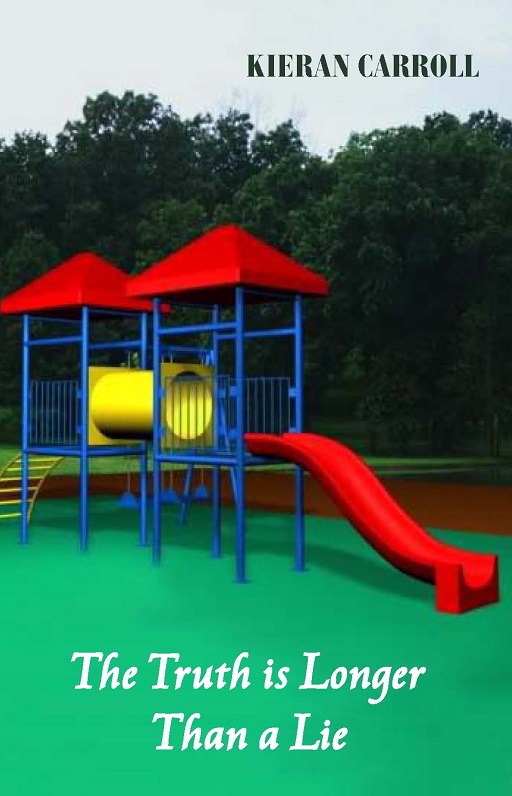 |
The Truth is Longer Than a Lie : |
|||||

Book Description ANDREA: I
married this man because I loved him and I thought he loved me, but
since our daughter was born he pays every minute of his attention to
her. I
mean, I would never want him to be neglectful or be uninterested in her
activities—but, doctor, I think my husband has an unusual fascination
with our
little girl… BEN:
Whatever I did to Amy I did it out of love…I
did it because she was the only person I idolised and cared about. I
could only
see the point of life when I gave all my love to her. The Truth is Longer than a Lie tells the crossover stories of the separate families of Amy and Spiderman, and of an anonymous child, whose story we hear in voiceover. It is a family drama. The adults Ben and Andrea or Rod and Paula are depraved, complicit or disbelieving. Andrea’s denial is particularly affecting. The family culture that Kieran Carroll’s drama unveils is that of child abuse. It is the children we come to know: their shame, their fear of disclosure, their urge to self-harm, their small window to healing given by counsellors and by their chance meeting. The authority of their young voices in Carroll’s dialogue will grip your heart. They are heroic. In their foreword Neerosh Mudaly and Chris Goddard from Child Abuse Prevention Research Australia, state: ‘If we are a moral and just society, we must protect children. If we are to protect children, we have to listen to them.’ The Truth is Longer than a Lie wrenches us into listening.
ISBN: 9781876044831 90 pages $23.00 |
||||||
Book Sample PRELUDE 2007 Ben
is
sitting at the kitchen table with his computer. He is staring intently
at
images, aroused by what he sees. He is conscious of what he is doing
and of
being caught. He hears the sound of Andrea entering and shuts down his
computer. Andrea moves towards him and tries to kiss him passionately. ANDREA: Thought I’d surprise you.
Amy’s over with
Harry and Zara. Rachel’s making them spaghetti bolognaise. I said I’d
go over
at 8. That gives us some time. Our lives are so busy— BEN: I like you being busy and
going out and
seeing your friends. Marriages need that freedom, that independence.
Andrea, I
might be worrying over nothing tonight but I’d just prefer Amy was here
with
us, that we were together as a family. Nothing against Rachel and her
kids. ANDREA: She’s fine. I thought we
could (Trying to be seductive)...
without her. BEN: It’s been a difficult day
at the office. Long
Pause BEN: Properties aren’t selling. Long
Pause BEN: What’s that look for?
Don’t let your
imagination play tricks. ANDREA: Why wouldn’t it? You only
ever turn away from
me. You never say I look beautiful. Do you ever initiate sex? Are you
scared
I’ll fall pregnant? BEN: I don’t want more
children. We’ve been
through this. Amy’s nine. Josh is almost off our hands. C’mon, why
don’t I grab
our incredible daughter and we can eat out at that fabulous Mexican
place? Amy
loves it there. ANDREA:
You’d tell me
if there was somebody,
wouldn’t you? BEN: You have nothing to worry
about. ANDREA: So it’s my old affair
then, is it? We’re
three years on and David still haunts us. Let’s go upstairs. Take your
clothes
off. How about a shower... mmm? Amy’s fine. BEN: I’d prefer dinner out.
Then we can see about
the bedroom. ANDREA: Don’t go and get Amy, Ben.
(Highly annoyed) You never want
anything
to be just the two of us, do you? BEN: If you insinuate... if you
ever say something
like that again... don’t provoke me. Andrea
grabs Ben’s arm. Ben breaks away. We see him make a call on his mobile. As he waits for the phone to answer,
Rod and Paula enter
from the other side of the stage. They are at the end of a night out,
looking
happy. It’s the early days of their relationship. Ben
speaks
on his mobile. BEN: Jack, g’day mate. I know
we’re locked in for
tennis tomorrow tonight—but look—I’ll have to be home with Amy. You
know what
it’s like, fatherly responsibilities. Anyway, I’ll call you and make
another
time. Say hello to that beautiful new wife of yours. Ben
exits.
Rod and Paula embrace in a nightclub. The Angels ‘Am I Ever Gonna See
Your Face
Again’ plays loudly as they dance for a minute and try to talk to one
another
over the music. Music fades. Reviews
The
statistics on the Australian Institute of
Health and Welfare websites are frightening. Every year approximately
55,000
children are the subjects of substantiations of notifications of
neglect and
abuse. One in thirty-seven children receive child protection services.
Indigenous children are seven times as likely to be receiving child
protection
services as non-indigenous children. As of June 30, 2014, 43,009
children in
out-of-home care were in relative/kinship or foster home care and 49
per cent
of foster care households had multiple children placed. Forty
per cent of these 55,000 children have
suffered emotional abuse, 28 per cent have been subject to neglect, 19
per cent
subject to physical abuse, and the remaining 14 per cent are victims of
sexual
abuse. Statistics such as these have given rise to a national
conversation,
highlighted in 2015 by the appointment of Rosie Batty as Australian of
the
Year. It
is therefore timely that Kieran Carroll’s
play The Truth is Longer than a Lie
should have had its first performance last November. Carroll’s play is
an
adaptation of the published PhD thesis of Neerosh Mudaly and Chris
Goddard,
which describes the rising incidence of child abuse and neglect in
Australia
and draws on case studies and true accounts by victims, their families,
school
counsellors, child protection unit workers and other agencies. Carroll’s
play echoes with the disturbing truth. It is direct, honest and
powerful in its
simplicity and its depiction of two families entangled in a web of
lies,
violence and despair. Carroll
has chosen to focus on two contrasting
families. Andrea and Ben, a successful real estate agent, live in an
affluent
suburb. Their teenage daughter, Amy, attends a prestigious school.
Since the
age of three, she has been sexually abused by her obsessive father, who
is
addicted to child pornography. Andrea
is in denial, while Paula finds herself
powerless to escape the horrible circumstances that confront her.
Gradually,
Amy and Paula are both forced to recognise the terrible consequences of
their
situations and seek urgent help. Amy confides in her school counsellor,
Janice,
while Paula seeks the assistance of the child protection unit after Rod
has
been shot by police who were responding to a report of domestic
violence. Amy
leaves her home to live with her best friend Jodie and her mother,
while Paula
takes Matthew to live with his grandmother. Carroll
relates the stories of Amy and Matthew
in twenty-seven short scenes. There is no need for elaboration or
theatrical
artifice. Each scene depicts a stage in the journey towards resolution,
as we
observe the eventual destruction of relationships and the family unit
and of
the physical and psychological well-being of the two children. Occasionally, the scenes are interspersed
with the verbatim voiceover accounts of a ten-year-old child. Though
brief,
they are a gut-wrenching testament to the horror of abuse of the
innocent. Carroll
cleverly avoids the pitfalls of
moralising and sensationalism. His short scenes allow his audience to
draw
their own conclusions about the morality of the perpetrators’ actions.
There
can be little doubt, given the raw realism of the dialogue and the
reality of
the setting of each scene in a home, at a nightclub, at the child
protection
unit, in a hospital or at a railway station, where Amy saves Matthew
from
leaping beneath a train. These
are
real people experiencing real abuse, struggling to repair their broken
lives
and confronting their fears.
Carroll’s world contains no fantastic
invention. His aim is not to excite our imaginations, but to provoke us
to take
responsibility as citizens to recognise, admit to and act upon a social
injustice, indeed a crime that needs to be justly and effectively dealt
with,
not only for the sake of those who are suffering but also for the
welfare of
society. Carroll’s
narrative is simply told, but its
message is complex. Like Mudaly and Goddard, he shows that only through
intervention can any possibility of resolution be reached. It may be
the
intervention of the police, acting upon a report by a neighbour. It may
be
because of the meeting between Amy and Matthew. It may be because of
their
referral to the child protection unit and the sympathetic and
enlightened
actions of Bronwyn, the child protection officer. While
it is clear that Ben and Rod are the
perpetrators of the terrible abuse, Carroll is careful not to apportion
a
stark, ill-considered judgment. He demonstrates the obsessive nature of
Ben’s
sexual addiction and Rod’s abuse as a child at the hands of his father,
acknowledging that the abused may become the abusers. He will present
the
empathetic professionalism of Bronwyn in contrast to the ignorant
ineffectualness of her colleague Danielle. All
the pieces of this complex puzzle are laid out in a drama that is
provocative
and compelling. Only truth can fit these pieces together to
make these
people’s lives whole once more. Matthew’s outburst will constantly remind us of our obligation to listen and believe: That’s
always the problem with these people
[professionals], they don’t want to believe the truth, they want to
believe the
easiest side ... They don’t want to hear the truth because the truth is
so much
harder to understand and so much longer than a lie about the truth. Carrol
has exposed the lie with scalpel-like precision and compelled his play
to utter
a truth that cannot be ignored. Peter
Wilkins is a theatre reviewer for the Canberra
Times.
|

